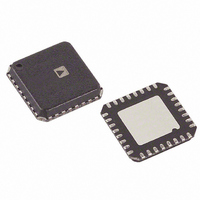AD9705BCPZ Analog Devices Inc, AD9705BCPZ Datasheet - Page 40

AD9705BCPZ
Manufacturer Part Number
AD9705BCPZ
Description
IC DAC TX 10BIT 175MSPS 32-LFCSP
Manufacturer
Analog Devices Inc
Series
TxDAC®r
Datasheet
1.AD9704BCPZ.pdf
(52 pages)
Specifications of AD9705BCPZ
Data Interface
Serial
Settling Time
11ns
Number Of Bits
10
Number Of Converters
1
Voltage Supply Source
Analog and Digital
Power Dissipation (max)
50mW
Operating Temperature
-40°C ~ 85°C
Mounting Type
Surface Mount
Package / Case
32-LFCSP
Resolution (bits)
10bit
Sampling Rate
175MSPS
Input Channel Type
Parallel
Supply Current
5.1mA
Digital Ic Case Style
CSP
No. Of Pins
32
Number Of Channels
1
Resolution
10b
Interface Type
Parallel
Single Supply Voltage (typ)
1.8/3.3V
Dual Supply Voltage (typ)
Not RequiredV
Architecture
Segment
Power Supply Requirement
Analog and Digital
Output Type
Current
Integral Nonlinearity Error
±0.36LSB
Single Supply Voltage (min)
1.7V
Single Supply Voltage (max)
3.6V
Dual Supply Voltage (min)
Not RequiredV
Dual Supply Voltage (max)
Not RequiredV
Operating Temp Range
-40C to 85C
Operating Temperature Classification
Industrial
Mounting
Surface Mount
Pin Count
32
Package Type
LFCSP EP
Lead Free Status / RoHS Status
Lead free / RoHS Compliant
For Use With
AD9705-EBZ - BOARD EVAL FOR AD9705
Lead Free Status / Rohs Status
Compliant
Available stocks
Company
Part Number
Manufacturer
Quantity
Price
Part Number:
AD9705BCPZ
Manufacturer:
ADI/亚德诺
Quantity:
20 000
AD9704/AD9705/AD9706/AD9707
APPLICATIONS
OUTPUT CONFIGURATIONS
The following sections illustrate some typical output
configurations for the AD9704/AD9705/AD9706/AD9707.
Unless otherwise noted, it is assumed that I
nominal 2 mA. For applications requiring the optimum
dynamic performance, a differential output configuration is
suggested. A differential output configuration can consist of
either an RF transformer or a differential op amp configuration.
The transformer configuration provides the optimum high
frequency performance and is recommended for any application
that allows ac coupling. The differential op amp configuration is
suitable for applications requiring dc coupling, signal gain,
and/or a low output impedance.
A single-ended output is suitable for applications where low
cost and low power consumption are primary concerns.
DIFFERENTIAL COUPLING USING A TRANSFORMER
An RF transformer can be used to perform a differential-to-
single-ended signal conversion, as shown in Figure 89. The
distortion performance of a transformer typically exceeds that
available from standard op amps, particularly at higher
frequencies. Transformer coupling provides excellent rejection
of common-mode distortion (that is, even-order harmonics)
over a wide frequency range. It also provides electrical isolation
and can deliver voltage gain without adding noise. Transformers
with different impedance ratios can also be used for impedance
matching purposes. The main disadvantages of transformer
coupling are the low frequency roll-off, lack of power gain, and
the higher output impedance.
The center tap on the primary side of the transformer must be
connected to a voltage that keeps the voltages on IOUTA and
IOUTB within the output common voltage range of the device.
Note that the dc component of the DAC output current is equal
to I
tap of the transformer should provide a path for this dc current.
In many applications, AGND provides the most convenient
voltage for the transformer center tap. The complementary
voltages appearing at IOUTA and IOUTB (that is, V
V
maintained with the specified output compliance range of the
AD9704/AD9705/AD9706/AD9707.
IOUTB
FS
AD9704/AD9705
AD9706/AD9707
/2 and flows out of both IOUTA and IOUTB. The center
) swing symmetrically around AGND and should be
Figure 89. Differential Output Using a Transformer
IOUTB
IOUTA
20
21
OPTIONAL R
OUTFS
DIFF
is set to a
IOUTA
R
LOAD
and
Rev. A | Page 40 of 52
A differential resistor, R
where the output of the transformer is connected to the load,
R
reflected by the transformer, is chosen to provide a source
termination that results in a low VSWR. Note that approxi-
mately half the signal power is dissipated across R
SINGLE-ENDED BUFFERED OUTPUT
USING AN OP AMP
An op amp such as the ADA4899-1 can be used to perform
a single-ended current-to-voltage conversion, as shown in
Figure 90. The AD9704/AD9705/AD9706/AD9707 are config-
ured with a pair of series resistors, R
feedback resistor, R
formula
The common-mode voltage of the output is determined by the
formula
The maximum and minimum voltages out of the amplifier are,
respectively,
LOAD
AD9704/AD9705
AD9706/AD9707
V
V
V
V
, via a passive reconstruction filter or cable. R
OUT
CM
MAX
MIN
=
=
=
=
V
V
R
V
REF
Figure 90. Single-Supply Single-Ended Buffer
FB
MAX
REF
IOUTA
IOUTB
REFIO
OTCM
×
×
×
−
I
⎛
⎜
⎜
⎝
FB
2
FS
1
⎛
⎜
⎜
⎝
I
1
21
20
, determines the peak signal swing by the
23
19
+
FS
+
R
×
DIFF
R
R
FB
R
B
R
R
FB
B
FB
, can be inserted in applications
S
⎞
⎟
⎟
⎠
R
⎞
⎟
⎟
⎠
−
S
V
OUT
R
C
B
S
, off each output. The
ADA4899-1
–
+
R
+5V
–5V
C
FB
F
DIFF
DIFF
.
, as
V
OUT













